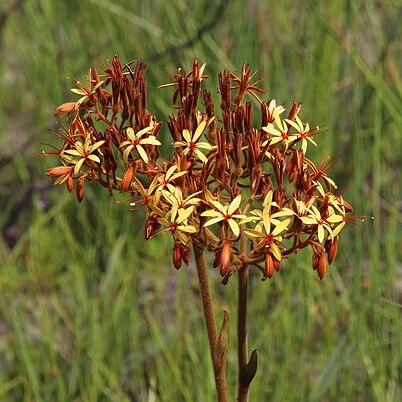Evergreen perennial, (150-)300-600 mm high. Rootstock a short woody rhizome with bright red flesh. Leaves several, distichous in conspicuous fans, unifacial, markedly equitant, linear to narrowly oblong, (60-)100-300(-500) x (4-)6-15(-20) mm, leathery, clasping below, glabrous or rarely with a few filiform gland-tipped hairs on sheath margins, flushed red basally. Stem erect, reddish orange, densely viscid-villous with filiform gland-tipped hairs 0.5-1.0 mm long; cauline bracts 4 or 5, scattered, foliose and ± inflated, upper bracts densely viscid-villous as for stem but lower subglabrous except along margins, gland-dotted. Inflorescence a thyrse, densely or rarely more laxly subumbellate to corymbose-paniculate or racemose-paniculate, branches reddish orange and densely viscid-villous as for stem. Flowers numerous, stellate, yellow above flushed orange beneath, deflexed in bud and obliquely ascending to erect at anthesis, enantiostylous; perianth actinomorphic, tepals spreading, subequal, linear-lanceolate, 10-15 x 2.5-3.5 mm, glandular-hairy on outer surface but inner series only along midline, conspicuously gland-dotted distally, persistent. Stamens three, dimorphic, prominently exposed; filaments unequal, subulate-filiform, adaxial erect, ±9 mm long, yellow with larger yellow anther 2.0-2.5 mm long, abaxial ± spreading, 11-14 mm long, reddish with smaller reddish anthers 1.0-1.5 mm long. Ovary subglobose, ±3 mm long, densely viscid-villous as for stem; style filiform, 10-16 mm long, flexed sideways (left or right in any one flower), reddish. Capsule 3-locular, ovoid-subglobose, septicidal, ±10 mm long, viscid-villous, glabrescent. Seeds solitary in each locule, oblong-discoid and shield-shaped, marginally winged, to 7 mm x 5 mm, dark brown.
More
Rhizomatous geophyte, 45-60 cm, stems reddish glandular-hairy. Leaves sword-shaped. Flowers in a corymbose panicle, enantiostylous, dull orange or yellow, tepals linear-oblanceolate, long stamens slightly longer than tepals, with anthers less than half as long as anther of short stamen.

